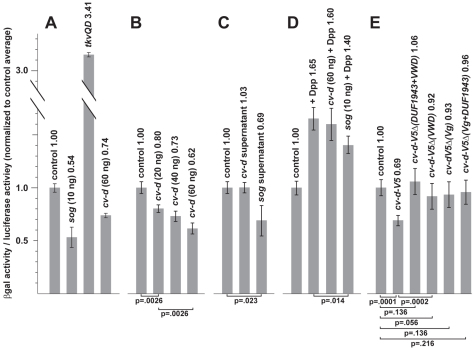Fig. 5.
Cv-d, but not Cv-d deletion constructs, inhibit BMP signaling in vitro. S2 cell signaling assays with the BMP-sensitive 3xUbx-lacZ construct. The y-axis shows the ratio of β-gal activity to control luciferase activity, which is normalized for each experiment to the average control value. The P values show comparisons between two selected columns using a single-tailed Mann-Whitney U-test. (A) Signaling is inhibited by transfection with sog and cv-d-V5, and increased by transfection with tkvQD. (B) Signaling is progressively inhibited by transfection with increasing amounts of cv-d-V5. (C) Signaling is inhibited by Sog-containing, but not Cv-d-containing, supernatant. (D) Signaling that was increased by the addition of recombinant Dpp is inhibited by sog but not by cv-d-V5 transfection. (E) Signaling is only reliably reduced by transfection with cv-d-V5, but the effects with the deletion constructs were significantly weaker [cv-d-V5 versus cv-d-V5Δ(VWD) comparison shown]. cv-d-V5Δ(VWD) may have slightly reduced signaling, but the effect was not significant.

